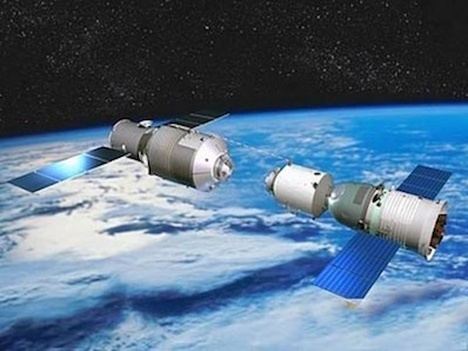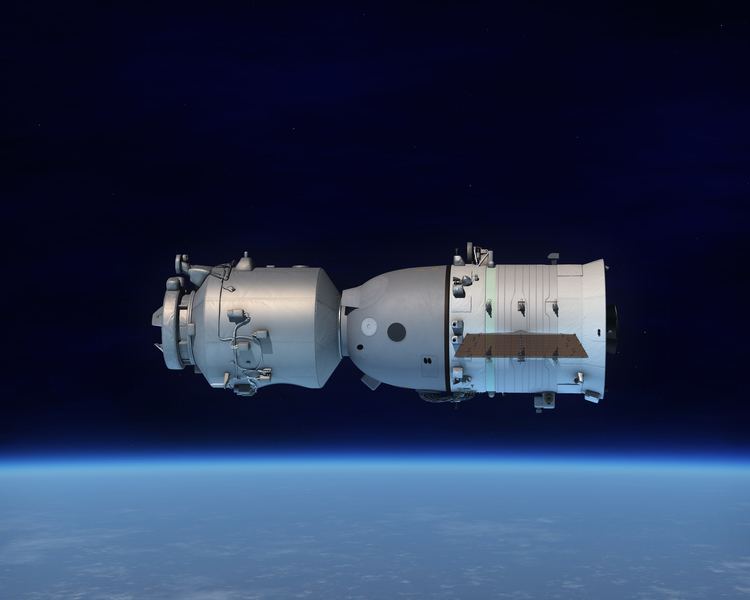Design life 20 days Launch mass 7,840 kg | Applications Manned spaceflight Status In service | |
 | ||
Dimensions 9.25 by 2.8 metres (30.3 ft × 9.2 ft) Volume 14.00 cubic metres (494 cu ft) Manufacturer China National Space Administration Similar Tiangong‑2, Tiangong‑1, Chang'e 2, Tianzhou, Chinese large mo | ||
Shenzhou (/ˈʃɛnˈdʒoʊ/ or /ʃɛnˈzuː/; Chinese: 神舟; pinyin: Shén Zhōu) is a spacecraft developed and operated by China to support its manned spaceflight program. The name is variously translated as "Divine Craft", "Divine Vessel of God", "Magic Boat" or similar and is also homophonous with an ancient name for China (written 神州; meaning "Divine State"). Its design resembles the Russian Soyuz spacecraft, but it is larger in size. The first launch was on November 19, 1999 and the first manned launch was on October 15, 2003. In March 2005, an asteroid was named 8256 Shenzhou in honour of the spacecraft.
Contents
- History
- Missions launched
- Planned missions
- Design
- Orbital module
- Reentry module
- Service module
- In Media
- References

History

China's first efforts at human spaceflight started in 1968 with a projected launch date of 1973. Although China launched an unmanned satellite in 1970 and has maintained an active unmanned program since, this attempt was canceled due to lack of funds and political interest.

The first unmanned flight of the spacecraft was launched on November 19, 1999, after which Project 921/1 was renamed Shenzhou, a name reportedly chosen by Jiang Zemin. A series of three additional unmanned flights ensued. It is expected that later craft will be designed to carry a crew of four instead of Soyuz's three, although physical limitations on astronaut size, as experienced with earlier incarnations of Soyuz, will likely apply.
Missions launched

Planned missions
Design
The Shenzhou spacecraft resembles the Soyuz, although it is longer, with a larger habitable volume. It features a powered service module like the Soyuz, and prior to Shenzhou 8 its orbital module was capable of autonomous flight. The general designer of Shenzhou-1 through Shenzhou-5 was Qi Faren (戚发轫, Apr 26, 1933 -), and from Shenzhou-6 on, the general design was turned over to Zhang Bainan (张柏楠, Jun 23, 1962 -).
In 1994, Russia sold some of its advanced aviation and space technology to the Chinese. In 1995 a deal was signed between the two countries for the transfer of Russian Soyuz spacecraft technology to China. Included in the agreement was training, provision of Soyuz capsules, life support systems, docking systems, and space suits. In 1996 two Chinese astronauts, Wu Jie and Li Qinglong, began training at the Yuri Gagarin Cosmonaut Training Center in Russia. After training, these men returned to China and proceeded to train other Chinese astronauts at sites near Beijing and Jiuquan. The hardware and information sold by the Russians led to modifications of the original Phase One spacecraft, eventually called Shenzhou, which loosely translated means “divine vessel.” New launch facilities were built at the Jiuquan launch site in Inner Mongolia, and in the spring of 1998 a mock-up of the Long March 2F launch vehicle with Shenzhou spacecraft was rolled out for integration and facility tests.
Like Soyuz, Shenzhou consists of three modules: a forward orbital module (轨道舱), a reentry module (返回舱) in the middle, and an aft service module (推进舱). This division is based on the principle of minimizing the amount of material to be returned to Earth. Anything placed in the orbital or service modules does not require heat shielding, and this increases the space available in the spacecraft without increasing weight as much as it would if those modules were also able to withstand reentry. Thus both Soyuz and Shenzhou have more living area with less weight than the Apollo CSM.
Orbital module
The orbital module (轨道舱) contains space for experiments, crew-serviced or operated equipment, and in-orbit habitation. Without docking systems, Shenzhou 1–6 carried different kinds of payload on the top of their orbital modules for scientific experiments.
Up until Shenzhou 8, the orbital module of the Shenzhou was equipped with its own propulsion, solar power, and control systems, allowing autonomous flight. It was possible for Shenzhou to leave an orbital module in orbit for redocking with a later spacecraft, something which the Soyuz cannot do since the only hatch between orbital and reentry modules is a part of reentry module, and orbital module is depressurized after separation. In the future it is possible that the orbital module(s) could also be left behind on the planned Chinese project 921/2 space station as additional station modules.
In the unmanned test flights launched to date, the orbital module of each Shenzhou was left functioning on orbit for several days after the reentry modules return, and the Shenzhou 5 orbital module continued to operate for six months after launch.
Reentry module
The reentry module (返回舱) is located in the middle section of the spacecraft and contains seating for the crew. It is the only portion of Shenzhou which returns to Earth's surface. Its shape is a compromise between maximizing living space while allowing for some aerodynamic control upon reentry.
Service module
The aft service module (推进舱) contains life support and other equipment required for the functioning of Shenzhou. Two pairs of solar panels, one pair on the service module, the other pair on the orbital module, have a total area of over 40 m² (430 ft²), indicating average electrical power over 1.5 kW (Soyuz have 1.0 kW).
In Media
The Shenzhou was prominently featured in the film Gravity and was used by the main character to safely return home after the destruction of her spacecraft.
Star Trek: Discovery is scheduled to include a Starfleet ship called the U.S.S. Shenzhou.
